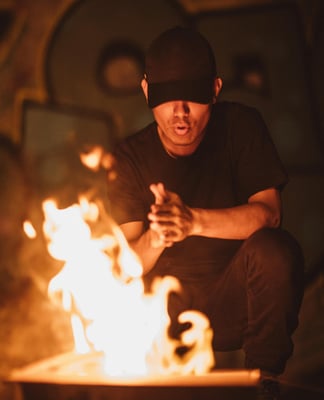Campfire Wood 101: Best Types for Camping and Responsible Foraging
There’s nothing quite like gathering around a campfire under the stars, sharing stories, and roasting marshmallows. But to create the perfect campfire, you need the right type of wood. Choosing the best campfire wood isn’t just about heat and flame—it’s also about safety, sustainability, and respecting nature. In this guide, we’ll explore the best types of wood for campfires, tips for responsible foraging, and how to build a fire that’s both efficient and eco-friendly. Whether you’re a seasoned camper or a first-time adventurer, this article will help you master the art of the campfire.
CAMPING
2/9/20253 min read
Why Choosing the Right Campfire Wood Matters
The type of wood you use for your campfire affects:
- Burn Quality: How long and hot the fire burns.
- Smoke Levels: Some woods produce less smoke, making for a more pleasant experience.
- Safety: Certain woods spark or pop, which can be dangerous in dry conditions.
- Environmental Impact: Using deadfall or sustainably sourced wood minimizes harm to ecosystems.
---
Best Types of Wood for Campfires
Here’s a breakdown of the top woods for campfires, along with their pros and cons:
1. Oak
- Pros: Burns hot and long, producing steady heat with minimal smoke.
- Cons: Hard to split and can be heavy to carry.
- Best For: Base logs to keep your fire burning through the night.
2. Maple
- Pros: Burns cleanly with a pleasant aroma.
- Cons: Less common in some regions.
- Best For: A reliable, all-purpose campfire wood.
3. Cedar
- Pros: Lights easily, produces a fragrant smoke, and repels insects.
- Cons: Burns quickly and can spark.
- Best For: Kindling or short, aromatic fires.
4. Birch
- Pros: Burns hot and fast, even when slightly damp.
- Cons: Produces more smoke than other hardwoods.
- Best For: Starting fires in wet conditions.
5. Pine
- Pros: Easy to find, lights quickly, and produces a bright flame.
- Cons: High resin content causes popping and sparks; burns fast.
- Best For: Kindling or short-lived fires (use with caution).
6. Hickory
- Pros: Burns hot and long with a pleasant, smoky aroma.
- Cons: Heavy and harder to split.
- Best For: Cooking over the fire (great for BBQ).
7. Apple
- Pros: Burns slowly with a sweet, fruity aroma.
- Cons: Less common and can be expensive.
- Best For: A luxurious campfire experience.
---
Woods to Avoid for Campfires
Not all wood is safe or suitable for campfires. Avoid these types:
- Green Wood: High moisture content makes it hard to burn and produces excessive smoke.
- Treated or Painted Wood: Releases toxic chemicals when burned.
- Poisonous Woods: Poison ivy, poison oak, or poison sumac can release harmful fumes.
- Driftwood: Salt content can release toxic chlorine gas when burned.
---
Responsible Foraging: Leave No Trace Principles
When gathering wood for your campfire, follow these guidelines to minimize your environmental impact:
1. Use Deadfall: Collect only fallen branches and twigs (deadfall) rather than cutting live trees.
2. Buy Local: If foraging isn’t allowed, purchase firewood from local vendors to prevent the spread of invasive species.
3. Small Sticks for Small Fires: Use only as much wood as you need—small fires are easier to control and leave less impact.
4. Respect Regulations: Some parks and campgrounds have strict rules about firewood collection. Always check before you gather.
5. Burn It All: Don’t leave partially burned wood behind—it’s unsightly and can harm the ecosystem.
---
How to Build the Perfect Campfire
1. Choose a Safe Spot: Use a designated fire ring or pit, and clear the area of flammable materials.
2. Gather Your Materials:
- Tinder: Dry grass, pine needles, or birch bark.
- Kindling: Small sticks or cedar shavings.
- Fuel Wood: Larger logs like oak or maple.
3. Build the Fire: Use the teepee, log cabin, or lean-to method to arrange your wood.
4. Light the Fire: Use matches, a lighter, or a fire starter to ignite the tinder.
5. Maintain the Fire: Add wood gradually to keep the fire at a manageable size.
6. Extinguish Completely: Douse the fire with water, stir the ashes, and repeat until cool to the touch.
---
Product Recommendations
- Fire Starters: Waterproof fire starters.
- Portable Fire Pits: Compact, eco-friendly fire pits for camping.
- Firewood Carriers: Durable bags for transporting firewood.
- Axe or Hatchet: Tools for splitting wood (e.g., Fiskars X7 Hatchet).
- Firewood Moisture Meter: Ensure your wood is dry enough to burn.
---
Conclusion
A campfire is more than just a source of warmth—it’s a centerpiece for memories and camaraderie. By choosing the right wood, foraging responsibly, and building your fire with care, you can enjoy a safe, sustainable, and unforgettable camping experience. So, pack your gear, gather your wood, and let the magic of the campfire light up your next adventure.
This post may contain affiliate links. If you make a purchase through these links, I may earn a small commission at no extra cost to you. Thank you for supporting FirewoodFanatic.com!


